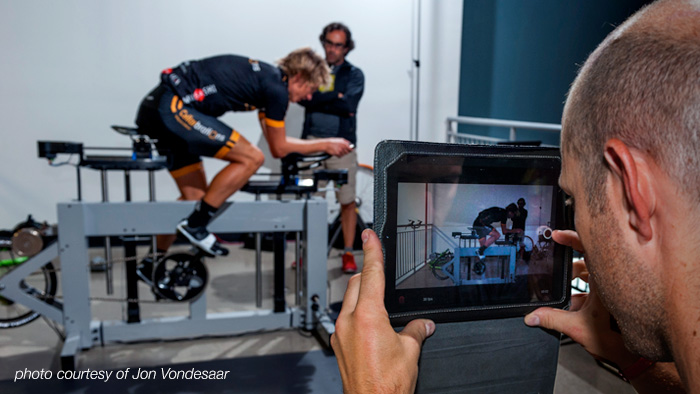Being professionally fit to your bike can save you as much time, if not more, than all of the aero equipment you can buy. Finding the right mix of comfort, power and aerodynamics is the ultimate goal. When considering these three components that contribute to your position on a bike, regardless of athletic experience, the order of importance is always comfort, power and then aerodynamics.
Comfort
Being comfortable on your bike does not mean upright, or non-aggressive, so get that notion out of your head right away. Comfort on a bike is paramount in the trilogy of bike fitting for one reason- time. The more comfortable you are in your aero position, the longer you can stay there. Ideally, you can maintain that position for the duration of your chosen event, regardless of whether it is a sprint or a full distance Ironman. Sitting upright with your hands on the base bar to shake out stiff or cramping triceps or lower back for a handful of minutes can cost you more time than all of the high dollar time saving aero goodies that you have assembled on your bike can save you over the course of a half Ironman, combined.
Comfort starts with the saddle. The proper pairing of athlete and saddle will allow the right amount of skeletal support, and soft tissue clearance, while also allowing the appropriate anterior pelvic rotation. With these established, you are able to relax your core and skeletally support yourself on the pads and extensions, and achieve an aerodynamic position.
Power
Power also starts at the saddle. When we position an athlete on their bike, we are trying to achieve the optimal saddle height, which will create an optimal open knee angle at the bottom of the pedal stroke, and the optimal closed hip angle at the top of the pedal stroke. If the open knee angle is too low, the muscle is not utilizing it’s full length of contraction, and it is costing you valuable power. Conversely if it is too high, you are constantly asking your muscle to work in a hyper-extension state which can lead to injury as well as robbing watts. Too closed of a hip angle will impede the legs ability to clear the top of the pedal stroke, also costing you power. And, believe it or not, positioning the front end of your bike the optimal distance away from your saddle and allowing your body to rest over the front end of the bike, will also contribute to your optimal power. If the front end is not positioned properly you will be requiring your core and upper body to maintain your position on the bike, instead of isolating your core and utilizing it to drive power downward to the pedals.
Aero
Only once your position is comfortable and your power is optimized, can you then start to modify minimization of frontal area, or chase aerodynamics. Ways to do this are:
- Optimize the aero helmet that is best suited for your particular position. Contrary to popular belief there is no such thing as “the fastest” anything when it comes to aerodynamics. One helmet may be faster on you than another because of how you posture your head and neck when in aero. A good fitter can help you identify which helmet will work best with your position.
- Optimize your upper arm and hand positioning. Use caution here because placing your elbows too narrow, or your hands too high could leave you in a compromised position that is not sustainable for the duration of your event or worse, deteriorate the handling of the bike.
- Learn to posture your head, hands and body for times during the race when you can take advantage of a “turtle” or “tuck”, or when you can “stack your hands”. These are valuable ways to save precious watts, but never at the expense of your safety or your sustainable comfort.
Again, I have only scratched the surface of the detail and the value of this topic, but I cannot stress enough the value of maintaining the integrity of your bike fit when searching for aerodynamics.



